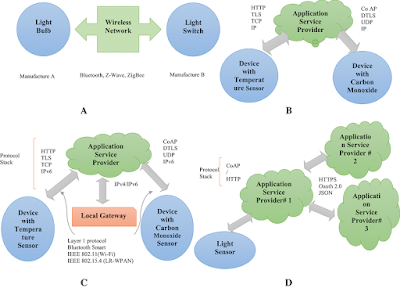4 IoT Models of Communication (Internet Architecture Board)
The Internet Architecture Board (IAB) elucidates a regulated architectural text for how little, well-dressed IoT system items interact link in terms of their methodological communication models.
Here are a few communication models that are often utilized by IoT devices and objects:
1. Device to Device communication
- In the Internet of Things, the Device-to-Device communication paradigm represents paired devices that connect and interact with each other directly, without the need for an intermediary server.
- In order to create direct connection, these devices employ protocols such as Bluetooth, ZigBee, and others.
- This communication model strictly follows one-to-one communication protocols to share information in order to perform their respective functionality.
- Bulb switches, door locks, washing machines, microwaves, refrigerators, and air conditioners are examples of home-based internet of things appliances that use device-to-device communication to transfer tiny data packets through low-rate data needs.
- Because device-to-device statement protocols are not well-suited, Device-to-Device communication necessitates the deployment/selection of like category devices.
2. Device to cloud communication model
- In the Device to Cloud communication architecture, IoT devices connect directly to a cloud service provider, who monitors data exchange and limits message volume.
- Abusers may have remote access to their states via their Smartphones, as well as install software upgrades, thanks to the cloud connection.
- This architecture makes use of an existing wired or wireless connection to establish a link between the device and the internet protocol network, which then connects to the cloud service.
- The device and cloud service must be from the same company in this case.
3. Device to Gateway communication model
- In the device to gateway paradigm, an IoT device communicates to a cloud service via an application layer gateway (ALG), which acts as a mouthpiece.
- When data is being sent, application software running on a local gateway works as an intermediate between the device and the cloud, as well as providing security-related activities.
- The smartphone becomes a local gateway device that runs an application to interact with other devices and send data to the cloud. Hub devices are used in home automation applications as a form of device to gateway paradigm, where Hubs act as a local gateway between individual IoT devices as well as a cloud service.
4. Back end data sharing model
- Import, export, and assess smart/small device records from a cloud service in a recipe with records from other sources using the back-end data sharing communication architecture.
- These models allow records or data generated by separate IoT devices to be aggregated and analyzed.
- This sort of communication protocol enables data portability when it is required; the abuser may relocate their records as they move across IoT devices.
- The data sharing approach on the back end is just as effective as the IoT system designs.
The ubiquitous presence of IoT devices will eventually allow for circulatory intelligence.
Understanding how diverse IoT devices interact with one another is crucial and helpful for operational perspective.
IoT communication paradigms have a lot to offer.
The Internet of Things (IoT) enables connections between people and things at any time, in any location, with anything and anybody utilizing any network or service.
4 Different Forms of Communication Based On Architecture
1. Request and Response Framework:
- The client-server architecture is used in this concept. When necessary, the client asks the server for the information. Typically, this request is in encoded form.
- Since each request is processed separately and no data is stored in between requests, this model is stateless.
- The request is classified by the server, which then retrieves the data from the database and its resource representation.
- This information is transformed into a response and sent to the client in an encoded manner.
- The answer is then given to the client.
- Contrarily, in the Request-Response communication paradigm, the client makes a request to the server, and the server answers.
- The server chooses how to reply to the request, gathers the necessary information and resources, prepares the answer, and then transmits it to the client.
2. Publisher-Subscriber Model:
- Publishers, brokers, and consumers are the three entities that make up this paradigm.
- The statistics are sourced from publishers.
- It transmits data to topics that the broker manages.
- Consumers are not known to them.
- Customers subscribe to the subjects that the broker manages.
- Therefore, it is the duty of brokers to take data from publishers and transmit it to the proper customers.
- The only consumer information the publisher is aware of that the broker possesses is that which pertains to a certain issue.
3. Push-Pull Model:
- Publishers, consumers, and queues of data make up the push-pull model.
- Consumers and Publishers are not conversant with one another.
- Publishers put the message or data onto the queue after publishing it.
- The data is retrieved from the queue by the consumers who are present on the opposite side.
- As a result, when there is a discrepancy between the pace at which data is pulled or pushed by a publisher and a consumer, the queue serves as a buffer for the message.
- The message between the producer and the consumer may be separated with the use of queues.
- Additionally, queues serve as a buffer, which is useful when the pace at which data is pulled by consumers and pushed by producers differs.
4. Exclusive Pair:
- Exclusive Pair is a bi-directional approach that enables full-duplex client and server communication.
- Up until the client submits a request to cancel the connection, the connection is continuous and open.
- All connections that have been made are recorded by the server.
- The server is aware of every open connection since this is a state-full connection model.
- This concept is the foundation of the whole WebSocket-based communication API.
Find Jai on Twitter | LinkedIn | Instagram












